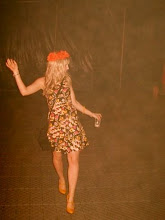I definitely want to keep this is mind for my TissueAid packaging. Colour and layou are key.




 I am pleased with the results, especially as this is my first 'design job'!
I am pleased with the results, especially as this is my first 'design job'!







 I am really drawn to this type of illustation, however I never seem able to re-create it in my own work. I do not think this is relevant to my project at the moment, however I do think it is an interesting use of colour. I limited selection of colours works well. Why confuse the piece by bringing other colours into it, stick with the same shades and tints. I also love the stock of this piece. This is definitely one thing I do need to start thinking about - what stock will work for my boxes and packaging. I also need to think about what mood and tone I am trying to portray.
I am really drawn to this type of illustation, however I never seem able to re-create it in my own work. I do not think this is relevant to my project at the moment, however I do think it is an interesting use of colour. I limited selection of colours works well. Why confuse the piece by bringing other colours into it, stick with the same shades and tints. I also love the stock of this piece. This is definitely one thing I do need to start thinking about - what stock will work for my boxes and packaging. I also need to think about what mood and tone I am trying to portray.
 I have put this piece in as I like the type and think the colours work really well together. Compliment each other a lot. I need to work on my colour palette and find a colour which can work for my logo and corporate ID throughout all the pieces of packaging.
I have put this piece in as I like the type and think the colours work really well together. Compliment each other a lot. I need to work on my colour palette and find a colour which can work for my logo and corporate ID throughout all the pieces of packaging.









 The top image is called 'subtractive colour'. This is because each colour blocks the reflection of colour, thus 'subtracts' colour. In other words the colours 'subtract' brightness from white. Hence the result of mixing all the colours together is black. This combination is CMYK and is for printing (litho or offset).
The top image is called 'subtractive colour'. This is because each colour blocks the reflection of colour, thus 'subtracts' colour. In other words the colours 'subtract' brightness from white. Hence the result of mixing all the colours together is black. This combination is CMYK and is for printing (litho or offset). Rotogravure (Gravure) uses copper plates (with mirror images). This process transfers the ink directly to the paper. The advantages of this process are that the plates are very durable, therefore brilliant for doing long runs, plus the colour quality is very high.
Rotogravure (Gravure) uses copper plates (with mirror images). This process transfers the ink directly to the paper. The advantages of this process are that the plates are very durable, therefore brilliant for doing long runs, plus the colour quality is very high. Flexography (Flexo) uses rubber polymer plates and an ink reservoir. A positive, mirror image is used and applies the sticky ink directly to the paper feed.
Flexography (Flexo) uses rubber polymer plates and an ink reservoir. A positive, mirror image is used and applies the sticky ink directly to the paper feed. Digital printing uses codes to reproduce digital images on physical surfaces. No intermediate physical process.
Digital printing uses codes to reproduce digital images on physical surfaces. No intermediate physical process. Pad printing is when a silicone pad is used to mould around the i and places a 2D design/image onto a 3D object. I.e. pens
Pad printing is when a silicone pad is used to mould around the i and places a 2D design/image onto a 3D object. I.e. pens
